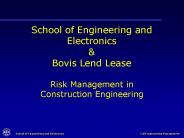B41E0235 The Influence of Climate on Root Depth Andrew J. Guswa Picker Engineering Program, Smith Co - PowerPoint PPT Presentation
1 / 1
Title:
B41E0235 The Influence of Climate on Root Depth Andrew J. Guswa Picker Engineering Program, Smith Co
Description:
constant rain frequency, variable mean depth. constant mean ... Rain events are stochastic (Poisson), instantaneous, and depths are exponentially distributed. ... – PowerPoint PPT presentation
Number of Views:38
Avg rating:3.0/5.0
Title: B41E0235 The Influence of Climate on Root Depth Andrew J. Guswa Picker Engineering Program, Smith Co
1
B41E-0235 The Influence of Climate on Root
DepthAndrew J. GuswaPicker Engineering Program,
Smith College, Northampton, MA,
aguswa_at_email.smith.edu
Results
Abstract
- Premise
- Root depth is determined by the depth at which
the marginal carbon cost of roots is equal to the
marginal benefit. - Roots will respond plastically to their
environment at time scales of weeks to months. - Roots will find and use water within the
root-zone.
- Goals
- Predict root depth as a function of the
intermittency and depth of rain events in both
wet and dry environments. - Develop a simple model that enables analytical
solution. - Illustrate the impacts of a changing climate on
root depth if water acquisition drives morphology.
Multiple factors including climate, vegetation
characteristics, soil properties, and nutrient
availability influence the morphology and extent
of plant roots. This work aims to provide
insight specifically to the control of climate
and rainfall variability on the depth of plant
roots. A simple stochastic model of
precipitation forcing and plant uptake is used to
balance the carbon costs and benefits of plant
roots and to determine an optimal rooting depth.
Precipitation events arrive instantaneously as a
Poisson process, and rainfall depths are
exponentially distributed the variability in
precipitation is thus characterized by two
parameters mean arrival rate and mean rainfall
depth. This model produces an analytical solution
for root depth as a function of three variables
mean rainfall depth normalized by plant-available
water content, aridity of the climate (determined
as the ratio of mean annual rainfall to potential
evapotranspiration), and a parameter that
combines potential evapotranspiration and
vegetation characteristics (root respiration
rate, specific root length, root-length density,
and water-use efficiency). Consistent with
observations, this model predicts the deepest
roots when annual rainfall is approximately equal
to potential evapotranspiration. In drier
environments, plant roots are limited by the
availability of water in wetter environments,
the roots are shallower for reasons of
efficiency. Except in very dry environments,
root depth tends to increase with decreasing
frequency of rain events for a given annual
rainfall. As the cost of plant roots increases,
root depth decreases as does the sensitivity of
root depth to climate variability. Results from
this simple model can provide insight to the
effect of a changing climate on root depth.
Water-optimal root depth
Efficiency of uptake
Water-optimal root depth
Efficiency of uptake
- Primary Conclusions
- For a given mean storm depth and vegetation and
soil characteristics, root depth is greatest when
rainfall and PET are approximately equal. In
drier environments, there is not enough water to
justify deeper roots in wet environments,
shallow roots are sufficient to meet potential
transpiration. - The sensitivity of root depth to mean
precipitation is roughly symmetric if the change
in precipitation is due to a change in rain
frequency if the change in rainfall is due to a
change in the depth of rain events, the
sensitivity of root depth to rain is much greater
in dry environments than in wet.
T/min(Tpot,al) -
Zr mm
Zr mm
T/min(Tpot,al) -
Model for Soil-Moisture Dynamics
Precipitation Rain events are stochastic
(Poisson), instantaneous, and depths are
exponentially distributed. The rainfall regime is
quantified by the frequency (l) and mean depth
(a) of events. When interception and bare-soil
losses are accounted for, the frequency of events
that produce water available to the vegetation
becomes
Evaporation Interception and bare-soil
evaporation have priority over transpiration and
are prescribed as maximum depths
Sensitivity of water-optimal root depth to
precipitation constant rain frequency,
variable mean depth constant mean depth,
variable frequency
Infiltration Water instantly fills the root zone
up to a maximum field-capacity saturation, Sfc
any excess water is lost to drainage and runoff.
Potential Transpiration Water is withdrawn from
the root zone at the potential transpiration rate
until the root-zone saturation reaches the
wilting point. The potential rate of
transpiration is equal to PET minus the average
rate at which water is lost to bare-soil and
interception evaporation.
Water-optimal root depth is achieved when the
marginal benefit of deeper roots equals the
marginal cost, i.e., when the carbon cost of
adding deeper roots is just balanced by the
incremental increase in photosynthesis due to
access to additional water
Mean precipitation mm/day
Mean Transpiration The normalized mean
transpiration rate as a function of the wetness
index, W, the plant available water content, q,
and the root depth, Zr, is based on Milly, P. C.
D., 1993, An analytical solution of the
stochastic storage problem applicable to soil
water, Water Resources Research, 29(11),
3755-3758.
Root zone Depth, Zr Porosity, n Field capacity,
Sfc Wilting point, Sw Plant-available water
content
Wetness Index, W -
Water-optimal root depth depends on three
variables
Water-Optimal Root Depth
The wetness index, W, is a stretched version of
the aridity index, AI.
Using the solution for T(Zr) from the stochastic
model for soil-moisture dynamics
Wetness of the climate Characteristic
infiltration depth Relative root cost































